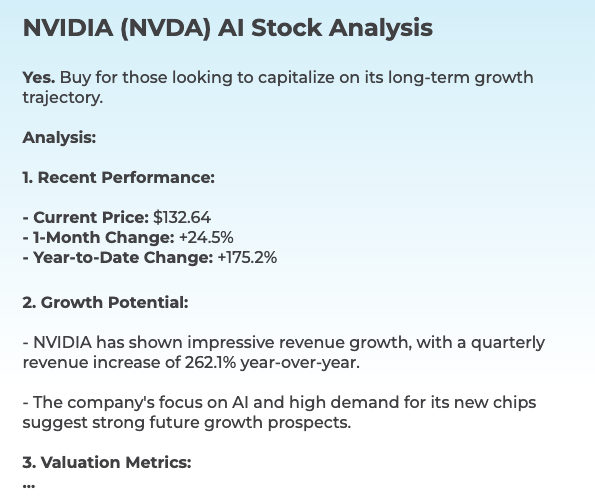20 Good Facts For Deciding On AI Stock Picker Platform Sites
20 Good Facts For Deciding On AI Stock Picker Platform Sites
Blog Article
Top 10 Tips For Assessing The Data Quality And Source Of Ai Stock-Predicting/Analyzing Trading Platforms
Assessing the quality of data and sources utilized by AI-driven stock predictions as well as trading platforms is essential for ensuring reliable and accurate insights. A poor quality data source can lead to false predictions, losses of money, and mistrust. Here are top 10 tips on evaluating the quality of data and the sources it comes from.
1. Verify the source of data
Find out where the data came from: Make sure you make use of reputable and well-known providers of data.
Transparency - The platform must be open about the sources of its data, and regularly update them.
Avoid relying on a single source: reliable platforms will typically combine data from multiple sources to lessen the chance of bias.
2. Assess Data Freshness
Real-time data vs. delayed data: Decide if the platform provides actual-time data, or delayed data. Real-time trading needs real-time data. Delayed data is sufficient for long-term analysis.
Update frequency: Make sure to check the frequency at the time that data is changed.
Historical data accuracy - Make sure that the historical records is consistent and without gaps or irregularities.
3. Evaluate Data Completeness
Check for missing or inaccurate data.
Coverage: Ensure that the trading platform supports a large number of the indices and stocks pertinent to your plan.
Corporate actions: Make sure that the platform records stock splits, dividends, mergers and other corporate actions.
4. Accuracy of Test Data
Cross-verify data: Examine the data of the platform with other reliable sources to ensure the accuracy of the data.
Look for mistakes by looking at the outliers or financial metrics that are incorrect.
Backtesting: Use historical data to backtest trading strategies and see whether the results are in line with the expectations.
5. Examine the Data Granularity
In terms of level of detail, make sure that the platform can provide a full set of data, including intraday pricing, volume, bidding-asking spreads and order book depth.
Financial metrics: Check whether your platform has comprehensive financial reports (income statement and balance sheet) and key ratios such as P/E/P/B/ROE. ).
6. Check for Data Preprocessing and Cleaning
Data normalization: To maintain consistency, ensure your platform is able to normalize every data (e.g. by adjusting for dividends and splits).
Outlier handling (handling anomalies) Check that the platform handles anomalies and outliers.
Missing data imputation: Check whether the platform is using effective methods to fill in gaps data points.
7. Evaluation of Data Consistency
Make sure that all data is aligned to the same timezone. This will avoid discrepancies.
Format consistency: Ensure that your data is presented in a consistent manner.
Cross-market compatibility: Ensure that data from different exchanges or markets are harmonized.
8. Assess Data Relevance
Relevance to the trading strategy Ensure the data aligns with your trading style (e.g., technical analysis or fundamental analysis, quantitative modeling).
Features Selection: Find out whether the platform has relevant features, such as sentiment analysis, economic indicators as well as news data which can improve forecasts.
Check the integrity and security of your data
Data encryption: Ensure the platform is encrypted to safeguard the data while it is being transmitted and stored.
Tamper-proofing (proof against tampering): Check to make sure that the data has not been altered or altered by the computer.
Compliance: Check whether the platform is compliant with data protection regulations (e.g. GDPR, GDPR or CCPPA, etc.).).
10. Test the platform's AI model Transparency
Explainability - Make sure that the platform gives you insights into the way in which the AI model makes use of the data in order to make predictions.
Verify that bias detection is present. The platform should actively detect and correct any biases that may exist in the model or in the data.
Performance metrics: To evaluate the reliability and accuracy of predictions, examine the performance metrics of the platform (e.g. precision, accuracy and recall).
Bonus Tips
User feedback and reputation Review user reviews and feedback to evaluate the platform's reliability.
Trial period: Try the platform for free to test the functionality and the features available before you commit.
Customer support: Make sure the platform provides robust support for data-related problems.
Utilize these suggestions to determine the data source and quality for AI software for stock prediction. Make informed decisions about trading by using this information. Follow the most popular https://www.inciteai.com/trader for blog recommendations including market ai, ai stock, ai for stock predictions, ai for investment, ai stock trading, ai chart analysis, ai stock market, chatgpt copyright, ai investing platform, stock ai and more.
Top 10 Ways To Assess The Speed And Latency Ai Technology For Predicting And Analyzing Stocks
Speed and latency is a critical factor when evaluating AI software for stock prediction or analyzing trading platforms. This is especially true for high-frequency traders, algorithmic traders and active traders. Even millisecond delays can have an impact on the profitability of the trade. Here are the top 10 ways to measure the speed of the platform.
1. Real-Time data feeds can be used to evaluate the accuracy of the real-time data you have
Time to deliver data: The platform must provide real-time, accurate data within an extremely short time (e.g. with sub-millisecond delay).
Closeness of data source: Determine the location of servers near major exchanges.
Data compression - Verify that the platform is using efficient techniques for data compression to increase data delivery speed.
2. Test Trade Execution Speed
Order processing time is the time that your order will be processed and executed by the platform.
Direct Market Access: Make sure that the exchange you use offers DMA. DMA is a feature that lets you send orders directly to exchanges, without intermediaries.
Execution reports: Check if the platform provides complete execution reports, which include timestamps for the submission of orders, confirmation of orders, and fill.
3. Review the responsiveness of the Platform
User interface (UI) speed: Test how quickly the platform's UI responds to your inputs (e.g., clicking buttons, loading charts).
Chart updates: Verify that charts and visuals are updated in real-time and without delay.
Performance of mobile apps. When using mobile apps, you should ensure it is performing as quickly and smoothly as the desktop version.
4. Find out if the network infrastructure is low-latency.
Location of servers: Make sure the platform is running a low-latency servers that are close to exchanges and financial hubs.
Co-location Services: Find out whether the platform supports co-location. This allows you to store your trading algorithms in servers located near the Exchange.
High-speed network: Determine if the platform is using high-speed fibre-optic networks, or any other low latency technology.
5. Backtesting the simulation speed and test backtesting
Test how fast the platform processes and analyzes old data.
The latency on platforms should be low enough to allow live simulations of trades in real time.
Parallel processing: Check that the system is running parallel processing, also known as distributed computing, to speed up complex computations.
6. Estimate API Latency
API response time Measuring how quickly the platform's API responds (e.g. getting market data, or placing orders).
Rate limits. Verify the API's rate limits in order to avoid delays while high-frequency trading.
WebSocket: Check whether the platform supports WebSocket protocols which permit streaming of data in real-time with low latency.
7. Test Platform Stability When Loaded
High-volume trades Test the platform's responsiveness and stability, simulate high-volume scenarios.
Test the platform in times of high volatility in the market to make sure it is able to withstand rapid fluctuations in price.
Stress testing: Find out whether the platform provides the tools to stress test your strategies under extreme circumstances.
8. Assess Connectivity and Network
Internet speed demands. Check that your connection is at the recommended speeds for the platform to ensure optimal performance.
Verify connections that are not redundant.
VPN latency - If you use a VPN for connection, make sure that it doesn't cause significant delay. Make sure that the service offers alternatives.
9. Make sure you are using Speed Optimization features.
Pre-trade analytics: Ensure the platform offers pre-trade analytics to improve the routing of orders and speed of execution.
Smart Order Routing (SOR). Verify that the platform uses SOR to identify the quickest and most cost efficient execution venues.
Utilize the tools of the platform to analyse and monitor latency in real-time.
Benchmarks for User Feedback Review
User reviews: Research feedback from users to evaluate the platform's speed and performance.
Third-party Benchmarks: Discover independent benchmarks to compare the performance of a platform against its competitors.
Case studies: Determine if a platform has instances or case studies that highlight the low-latency features.
Bonus Tips:
Trial time: You are able to make use of a demo or trial to test out the performance and latency of the platform.
Support for customers: Make sure the platform offers assistance with issues related to latency, or for optimization.
Hardware requirements: Check whether you require specific hardware for optimal performance (e.g. high-performance PCs).
If you follow these guidelines that you will be able to assess the speed and latency of AI stock predicting/analyzing trading platforms, ensuring you choose a platform that meets the requirements of your trading and eliminates the time it takes to complete. The need for low latency is vital for high-frequency and algorithmic traders. Even the smallest delay can have a huge impact on profits. Follow the top best ai trading platform url for blog advice including free ai stock picker, can ai predict stock market, ai stock price prediction, ai stock predictions, ai trading tool, free ai tool for stock market india, ai for trading stocks, ai trading tool, best ai for stock trading, best stock prediction website and more.